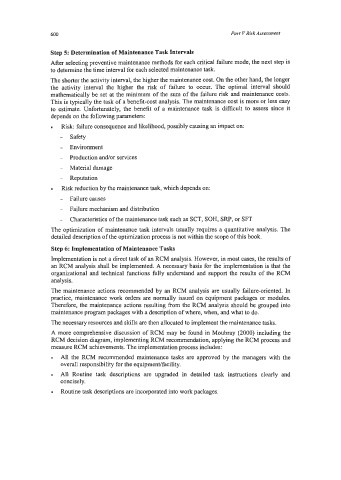Page 624 - Marine Structural Design
P. 624
600 Part V Risk Assessment
Step 5: Determination of Maintenance Task Intervals
After selecting preventive maintenance methods for each critical failure mode, the next step is
to determine the time interval for each selected maintenance task.
The shorter the activity interval, the higher the maintenance cost. On the other hand, the longer
the activity interval the higher the risk of failure to occur. The optimal interval should
mathematically be set at the minimum of the sum of the failure risk and maintenance costs.
This is typically the task of a benefit-cost analysis. The maintenance cost is more or less easy
to estimate. Unfortunately, the benefit of a maintenance task is difficult to assess since it
depends on the following parameters:
Risk failure consequence and likelihood, possibly causing an impact on:
- Safety
- Environment
- Production and/or services
- Material damage
- Reputation
Risk reduction by the maintenance task, which depends on:
- Failure causes
- Failure mechanism and distribution
- Characteristics of the maintenance task such as SCT, SOH, SRP, or SFT
The optimization of maintenance task intervals usually requires a quantitative analysis. The
detailed description of the optimization process is not within the scope of this book.
Step 6: Implementation of Maintenance Tasks
Implementation is not a direct task of an RCM analysis. However, in most cases, the results of
an RCM analysis shall be implemented. A necessary basis for the implementation is that the
organizational and technical functions fully understand and support the results of the RCM
analysis.
The maintenance actions recommended by an RCM analysis are usually failure-oriented. In
practice, maintenance work orders are normally issued on equipment packages or modules.
Therefore, the maintenance actions resulting kom the RCM analysis should be grouped into
maintenance program packages with a description of where, when, and what to do.
The necessary resources and skills are then allocated to implement the maintenance tasks.
A more comprehensive discussion of RCM may be found in Moubray (2000) including the
RCM decision diagram, implementing RCM recommendation, applying the RCM process and
measure RCM achievements. The implementation process includes:
All the RCM recommended maintenance tasks are approved by the managers with the
overall responsibility for the equipment/facility.
All Routine task descriptions are upgraded in detailed task instructions clearly and
concisely.
Routine task descriptions are incorporated into work packages.

